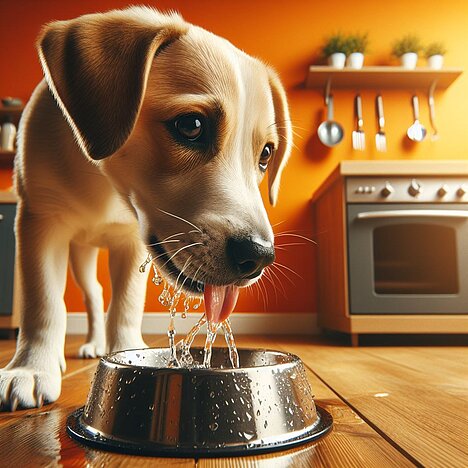Excessive thirst

If your dog is drinking more than usual, this can be a sign of a serious illness. Excessive thirst, also known as polydipsia, can indicate diabetes, kidney problems, liver disease or other health conditions. In this article you will learn how to recognize excessive thirst in your dog, what the possible causes are and how you can help him.
How much water does a dog need?
The amount of water a dog needs each day depends on various factors, such as its size, weight, activity level, food and ambient temperature. A rule of thumb is that a dog should drink around 50 to 100 milliliters of water per kilogram of body weight. This means that a dog weighing 10 kilograms needs about half a liter to one liter of water per day.
Of course, water requirements can vary depending on the situation. If your dog does a lot of exercise, is outside in hot weather or eats dry food, it will need more water than usual. On the other hand, if he eats wet food or is not very active, he may drink less water.
What is excessive thirst in dogs?
Excessive thirst in dogs is when a dog drinks significantly more water than normal. This can manifest itself, for example, in the dog emptying its water bowl more frequently, drinking from other sources such as puddles or toilets or drooling more often. Excessive thirst is often accompanied by frequent urination, which is known as polyuria.
Excessive thirst and frequent urination can be symptoms of various conditions that affect the dog's fluid balance. These include
- Diabetes mellitus: this is when the dog's body does not produce enough insulin or no longer responds to it. Insulin is a hormone that regulates blood sugar levels. If the blood sugar is too high, the body tries to excrete it via the urine. This leads to increased fluid loss and an increased feeling of thirst.
- Diabetes insipidus: In this case, the dog's body does not produce enough vasopressin or no longer responds to it. Vasopressin is a hormone that controls water absorption in the kidneys. If there is too little vasopressin or the kidneys do not respond to it, too much water is excreted and the dog has to drink more.
- Kidney problems: This is when the dog's kidneys no longer function properly and can no longer filter the blood adequately. This leads to an accumulation of waste products in the blood and a loss of electrolytes and water in the urine. The dog must drink more to compensate for the loss of fluids.
- Liver disease: In this case, the dog's liver is damaged and can no longer fulfill its many tasks. Among other things, the liver is responsible for detoxifying the body, producing bile and regulating the metabolism. If the liver fails, toxins accumulate in the blood and hormones and enzymes become imbalanced. This can lead to an increased feeling of thirst.
- Cushing's syndrome: The dog's body produces too much cortisol or receives it from outside. Cortisol is a hormone that is involved in the stress response and influences many metabolic processes. Too much cortisol can lead to increased water intake and excretion.
- Other diseases: There are other possible causes of excessive thirst in dogs, such as infections, tumors, poisoning, medication or hormonal imbalances.
How can I help my dog?
If you notice that your dog is drinking more than usual, you should take him to a vet. The vet can make an accurate diagnosis and initiate the appropriate treatment. Depending on the cause, the treatment may consist of medication, a change in diet, fluid therapy or surgery.
You can also help your dog at home by always providing him with fresh water and monitoring his water intake and excretion. If you notice that he is drinking or urinating more than normal, you should report this to the vet. You should also make sure that your dog does not drink from unhygienic sources such as puddles or toilets, as this can lead to infection.
Excessive thirst in dogs is a serious symptom that should not be ignored. If you get your dog the medical care he needs in time, you can improve his quality of life and increase his life expectancy.
The authors assume that a veterinarian should be consulted if an animal is ill and that medication should only be taken after consultation with a doctor or pharmacist. Only an individual examination can lead to a diagnosis and treatment decision.
We help you find the nearest vet → This way